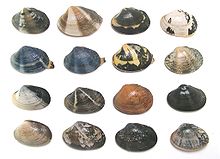Ruditapes philippinarum
| Ruditapes philippinarum | |
|---|---|

| |
| Scientific classification | |
| Domain: | Eukaryota |
| Kingdom: | Animalia |
| Phylum: | Mollusca |
| Class: | Bivalvia |
| Order: | Venerida |
| Superfamily: | Veneroidea |
| Family: | Veneridae |
| Genus: | Ruditapes |
| Species: | R. philippinarum
|
| Binomial name | |
| Ruditapes philippinarum | |
| Synonyms | |
| |
Ruditapes philippinarum, the Manila clam,[1] is an edible species of saltwater clam in the family Veneridae, the Venus clams.[2][3]
Description[edit]
The shell of Ruditapes philippinarum is elongate, oval, and sculptured with radiating ribs.[4] It is generally 40 to 57 millimeters wide, with a maximum width of 79 millimeters.[5]
Distribution[edit]
This clam is native to the coasts of the Indian, Philippines and Pacific Oceans from Pakistan and India north to China, Japan, Korea and the Kuril Islands.[6]
Habitat[edit]
This burrowing clam is most abundant in subtropical and cooler temperate areas. It can be found in shallow waters in substrates of coarse sand, mud, and gravel.[5] It lives in the littoral and sublittoral zones.[7] It burrows no more than about 10 centimeters into the substrate. It sometimes lives in eelgrass beds.[7]
This species lives in many types of habitat, being found in the intertidal zone, brackish waters,[7] estuaries, and under ice. It survives in a range of salinities and temperatures, with narrower ranges required for breeding.[5]
Biology and ecology[edit]
This clam may become sexually mature in its first year of life, when it reaches about 15 millimeters in width, especially in warmer areas such as Hawaii. In cooler areas it begins breeding at older ages and larger sizes. In warmer regions it spawns year-round, but only in the summer in cooler areas. The fecundity of the species increases with size, a 40-millimeter female producing up to 2.4 million eggs.[5]
References[edit]
- ^ Cordero, David; Delgado, Marina; Liu, Baozhong; Ruesink, Jennifer; Saavedra, Carlos (3 January 2017). "Population genetics of the Manila clam (Ruditapes philippinarum) introduced in North America and Europe". Scientific Reports. p. 39745. doi:10.1038/srep39745.
- ^ "Ruditapes philippinarum". MolluscaBasee. Retrieved 27 April 2024.
- ^ "Ruditapes philippinarum". Catalogue of Life. Retrieved 27 April 2024.
- ^ Morris, R.H., Abbott, D.P., & Haderlie, E.C. (1980). Intertidal Invertebrates of California. Stanford, CA: Stanford University Press.
- ^ a b c d Fofonoff P. W., et al. Venerupis philippinarum. National Exotic Marine and Estuarine Species Information System (NEMESIS). Accessed 22 May 2017.
- ^ Ruditapes philippinarum. Fisheries and Aquaculture Department, FAO. 2017.
- ^ a b c Palomares, M. L. D. and D. Pauly (Eds.) Ruditapes philippinarum. SeaLifeBase. Version February 2017.
Further reading[edit]
- Milan, M. et al. 2011. Transcriptome sequencing and microarray development for the Manila clam, Ruditapes philippinarum: Genomic tools for environmental monitoring. BMC Genomics 12:234.
- Talley, D. M., Talley, T. S., & Blanco, A. 2015. Insights into the Establishment of the Manila Clam on a Tidal Flat at the Southern End of an Introduced Range in Southern California, USA. PLoS One 10(3): e0118891.
External links[edit]
 Media related to Venerupis philippinarum at Wikimedia Commons
Media related to Venerupis philippinarum at Wikimedia Commons Data related to Ruditapes philippinarum at Wikispecies
Data related to Ruditapes philippinarum at Wikispecies

